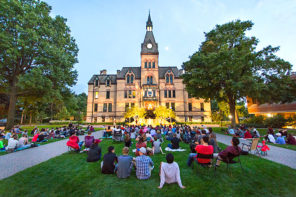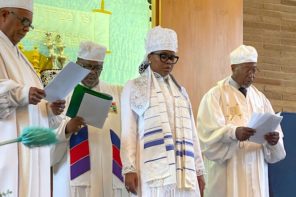It’s Really All About God: Reflections of a Muslim Atheist Jewish Christian
by Samir Selmanovic
(Jossey-Bass, 2009)
Everything Is God: The Radical Path of Nondual Judaism
by Jay Michaelson
(Trumpeter, 2009)
A particular school of Jewish mysticism holds that the world exists by virtue of the absence of God. Rabbi Isaac Luria, the semi-legendary 16th-century kabbalist, taught that in order to make room for the cosmos, the Godhead, which permeated all space and time, had to contract itself—an act known in Hebrew as tzimtzum. The result is a spiritual paradox; a universe of creatures yearning for a Power whose unmitigated presence would obliterate them.
This cosmology is a good metaphor for the complicated relationship between religions and God, something not nearly as straightforward as fundamentalists, whether of the believing or disbelieving variety, may imagine it to be. Though, nominally, religion can be understood as a human social form organized around the worship of a deity, it seems to operate quite often in the absence of the divine. Skeptics would argue that this is because God, in Woody Allen’s phrase, “is an underachiever.” But even some committed religious functionaries have suggested, often in the light of scientific insight, that supernatural claims be deemphasized in favor of the salvific power of the people themselves; God, in the traditional sense, experiences a tzimtzum, so as to engender a new burst of cultural creativity.
But everything goes in cycles, even celestial semantics. One concept that emerged in the wake of Luria’s theory is known as ratso v’shov (literally “running and returning”), a term adapted from a description of the prophet Ezekiel’s psychedelic visions. How can we mediate between communing with God and the persistence, whether needful or desired, of material reality? Through an alternating current of attachment and separation. Similarly, while there may be moments militating for a “return from” God toward a more productive religious mundanity, they oscillate with a “running” in the opposite direction; the suggestion that religion without God is either stale or corrupt, a rogues gallery ranging from the strawman Pharisees of the New Testament to Ivan Karamazov’s Inquisitor. The reintroduction of God, however, as Luria would tell us, leads to nothing less than the obliteration of the known world.
God-Management Systems?
Two new works of progressive theology, whose nearly identical titles both appear to advocate an undoing of the tzimtzum, might therefore be greeted with trepidation: It’s Really All About God by Samir Selmanovic, and Everything is God by Jay Michaelson. Beneath the covers of these books, which are also remarkably similar in design (the word “God” swelling up against a solid white background to dwarf all of the other characters) lie two overlapping but distinct arguments. The first is a passionate apologetics for a platform of interfaith unity and the second a metaphysical treatise, blending traditional Judaism with the wisdom of the East.
Both authors fit within the demographic of Generation X, though with widely differing biographies. Selmanovic, in his early forties, is Croatian by birth, the son of a secular Muslim family who came of age in communist Zagreb and embraced Christianity during mandatory service in the Yugoslav army; a transformation that led to a schism with his family and his immigration to America for seminary training. He is the founder of Faith House Manhattan, “an experiential interreligious community” that attempts to establish a common space for devotion and social action, though by trade he is a Seventh Day Adventist minister. Michaelson, in his late thirties, is a freelance teacher of Jewish spirituality, known particularly as the leader of Nehirim, an organization fostering spiritual consciousness among GLBT Jews. A poet and prolific essayist, he is also co-founder of the literary journal Zeek, and a regular voice in the Jewish press (and lately the Huffington Post), whose writing challenges the ethnic and mythological components of Jewish identity for the sake of an atomized Judaism composed of an array of “spiritual practices.”
Michaelson admits the insurgent nature of his project in the subtitle of his book—“The Radical Path of Nondual Judaism”—which also introduces the intertwining terms that preoccupy his thought. “Nonduality,” he explains, “is found at the summit of nearly every mystical tradition in the world… according to the nondual view, the phenomena, boundaries, and formations which constitute our world are fleeting, and empty of separate existence.” This concept should be familiar to even a casual student of Buddhism (the notion that all distinctions are illusory and ultimate reality an unfathomable oneness), and Michaelson stands in a proud line of Jews who have been anything but casual students. Everything is God represents one of the more erudite attempts to situate nondualistic insights in Jewish material. At its core lies the fact that Judaism, being a “theistic” tradition, makes use of the word “God,” which, following certain esoteric doctrines of the Kabbalah, Michaelson associates with the essential unity of nondualism. “To be sure,” he writes, “this is a God very different from the ordinary one… neither a paternalistic judge nor a partisan warrior, but Ein Sof, Being and Nothingness, without end or limit.”
Selmanovic’s argument for the centrality of God operates on the level of social relations rather than metaphysics, but his subtitle is equally indicative: “Reflections of a Muslim Atheist Jewish Christian.” The provocative immodesty of this assertion (though Selmanovic can claim secular and Muslim pedigree he has quite clearly made his home in Christianity, and his Jewish bona fides are unapparent) is precisely the author’s point. An obsession with purities of doctrine and identity, he argues, renders religions into what he cleverly terms “god-management systems,” preoccupied with contentions of their own supremacy and bereft of the living God. “I have been questioning the certainty of my religious insider-outsider worldview,” he writes. “Such certainty had a tendency to divide my world and isolate me from the ‘outsiders’ who… I believed, could not teach me, bless me, or correct me in the matters of God.” His remedy is to postulate a deity beyond any one particular faith, orienting the seeker in the direction of the other.
Romantic Religion
Both authors are well aware of the trenchancy of the “New Atheism”—the stark articulation of divine absence, which takes the form of a two-pronged attack: God is both patently untrue, and morally reprehensible. Selmanovic seems more troubled by the second critique, grounding his case for a God who transcends particular traditions in a lament over the abuses of fundamentalism. He also plots ethical secularism along the spectrum of religious commitment, lauding its potential to curb the extravagancies of belief. But he is not nearly as concerned with the issue of the reality of the divine as Michaelson, who repeatedly suggests that his denatured God, the totem of a panentheistic mysticism, harmonizes with the revelations of neuroscience and evolutionary biology. Following spirituality guru Ken Wilber, Michaelson even proposes that the experiences that result from methodological immersion in such a theology can be verified by scientific empiricism. “Repeat the procedure,” he writes, “and see what happens.” It is not coincidental, given this awareness of atheism, that both Michaelson and Selmanovic are romantics. “Opinions are secondary,” writes Michaelson, “love, fear, yearning are at the root.” Selmanovic similarly places passionate longing at the core of religion, though in terms more redolent of the veneration of a crucifix. “We exist,” he writes, “but we want more. Sometimes it feels like a dull pain, sometimes a sharp cut, as spirit enters flesh.” Such eroticism seems to flourish precisely at moments when intellectual data challenges faith, shifting the burden of proof from thought to emotion and privileging mysticism over strict rationality; justifying the existence of God according to the desire for God, and the extent to which God is felt.
But neither writer is anti-intellectual. Michaelson, in particular, takes pains to delineate the complex schema—nearly as mind-bending as a time-travel film—through which the world of divisions is folded into the continuity of the absolute. “The third stage,” of nondualistic perception, he writes, is “to return to the experience of duality while maintaining the consciousness of unity… what David Loy calls the ‘nonduality of duality and nonduality.’” He uses the abovementioned terminology of ratzo v’shov to describe this movement, a kind of playful back-and-forth between God’s perspective and a state of self-conscious illusion. It is this interplay that allows him to make space for Jewish particularity against the backdrop of the infinite. “We approach the Absolute from the Relative,” he writes, “the universal from the particular. These are my people, my family—which is doubtless why I sometimes can’t stand them.”
Michaelson is most compelling when he speaks in this vein: elaborating nondualistic understandings of God inside the parameters of Jewish identity. For his part, Selmanovic becomes problematic when his decrying of religious difference takes the form of a glib, uninformed universalism. Drinking in the wisdom of an “old rabbi from Brooklyn,” he remarks, “I realized that Jesus, a Jewish rabbi, would say [the same thing.]” Similarly, he inveighs against “we who have shrunk the sacred,” by forgetting that “sleeping, eating, working, talking, washing” are in fact “spiritual things,” seemingly oblivious to the fact that he has just listed the bread-and-butter obsessions of the Talmud. This is not to say that Judaism is immune to his criticism of religious chauvinism, but only to highlight that the inherent danger of universalistic programs is that they bleed so easily into self-projection, with implications ranging from homogenization to imperialism.
But if Selmanovic’s God imposes upon religious identity from without, then Michaelson’s appears to be exploding it from within. This point becomes clearer when Everything is God is read in the context of his other work, where nondualism seems less a cartridge to be inserted into the theology slot of a stable Judaic apparatus, than a discombobulating burst of the numinous leading to a reconfiguration of the very terms of Jewish being. For Michaelson, again, this tends to entail a revaluation of the elements of Jewish religion according to their worth as “spiritual practices” (as opposed to time-honored myths and rituals holding families and communities together), which he arrays in a panoply alongside vispassana meditation, neo-paganism, and Burning Man. In doing so, he may be as much describing a facet of contemporary Jewish reality as fomenting it, though it remains to be seen whether that means heralding a rebirth or chronicling the disintegration of a people, in the midst of an individualistic and sensually-overloaded consumer society.
Modern Restlessness, Marketplace Multiculturalism
The cosmology of tzimtzum suggests that every extension of the Godhead entails the destruction of whatever persisted in its absence. Though Selmanovic and Michaelson do both provide a space for religious particularity, this seems, more than anything else, to be the threatened entity. It is possible to trace in their writings the formation of a kind of syncretistic constellation, made of modern restlessness and marketplace multiculturalism, and illuminated by the yearning for a palatable God. It is unclear what its gravity will be, and how tradition will articulate itself in response: what place will be found for religion that does not purport to offer sensual access to the divine, but seeks instead to bolster communal solidarity and pass on intergenerational legacies; what arguments can be mustered for refusing, without violence, an easy universalism. Luria knew that the expansion of God, both longed for and feared, like a passionate and smothering embrace, had to be mediated. It may prove, in the end, that even if everything is God, God should not be what it’s really all about.




